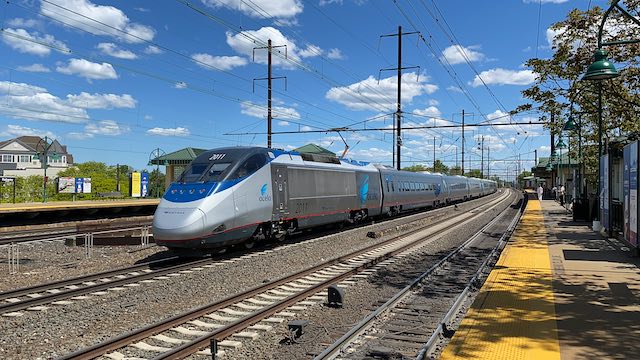Just before the pandemic, Amtrak proudly announced that it lost only $29.5 million operating passenger trains in 2019 and expected to make an operating profit in 2020. Of course, that didn’t happen thanks to the pandemic, and what’s more, it was lying about losing only $29.5 million; its actual losses were closer to $1.4 billion, a mere 46 times more than it claimed.
Amtrak spent $2.5 billion on new trainsets for its high-speed Acela. These were supposed to go into service in 2021 but are now expected to begin service no sooner than 2023. Photo by Fan Railer.
Now that Congress has flooded Amtrak with money in the infrastructure bill, however, the agency no longer even cares about whether its passenger trains come close to covering their costs. Like any good soviet agency, it recently released its five-year plan, and it projects it will lose more than a billion dollars a year for almost every year in the future.
Needless to say, the billion-dollar-a-year loss is also a lie as it ignores the same factors as the claimed $29.5 million loss in 2019. First, it counts state subsidies to Amtrak as possenger revenues. Second, it pretends depreciation, the second-largest cost on its operating budget, doesn’t exist. Plus, the five-year plan reveals a third way Amtrak lied in 2019: it includes a line item called “ancillary expense,” which as near as I can tell includes costs that can’t be attributed to any specific train. This was $309 million in 2019, meaning actual losses that year were $1.7 billion.
Deducting state subsidies and depreciation, operating losses in 2023 through 2027 will average more than $2.4 billion. This just counts operating costs, of course; during those years, Amtrak anticipates spending $6.5 billion a year on capital projects.
The operating budget projects that fares will recover to 2019 levels in 2024. By 2027, Amtrak hopes they will be 22 percent more than in 2019. State subsidies, Amtrak anticipates, will increase by 128 percent from $234 million in 2019 to $533 million in 2027. I hope the states resist the temptation to give Amtrak that much money.
Salaries are expected to increase by 55 percent and total costs (not counting depreciation) by 44 percent. The five-year plan doesn’t predict depreciation, but with all of the capital improvements, this is bound to grow. However, for these calculations, I assumed it would remain constant at 2021 levels.
In short, Amtrak plans to spend $6.5 billion a year on capital improvements and to increase its operating costs by at least 44 percent in order to get a 22 percent increase in ticket revenues. That doesn’t make much sense from a business or economic point of view. From a political point of view, of course, revenues or even passengers don’t really count. All that really counts is that the money goes to people who will be grateful to the politicians who authorized the spending.









If there was a real limit or cap on federal spending, every dollar spent on Amtrak would have to come from some other program. But alas, congress and the executive believe that our capitalist system, well-educated, hardworking and ambitious citizens and our amber waves of grain can never run out of money.
We can’t spend our way out of fiscal poverty, but we can and must earn our way out. Amtrak is a sink, not a source.
Amtrak was founded on the behalf of future idea it would become a well run and inevitably private enterprise.
50 years went from StRtup company…. to federal welfare caseload.
Amtrak was created + designed to one thing and only one thing —-> preserve passenger rail service in the US.
There was and is a lot of rhetoric and claims about other things, other goals. It was supposed to turn a profit, etc, etc. Amtrak was _never_ ____designed___ to do such a thing.
Should it turn a profit? Should we put more $$$$$$$$$$$$ to expand it’s network? Those may be current issues but Amtrak wasn’t formed to address them. And it’s structure has never gone through any sort of changes to address them. them.